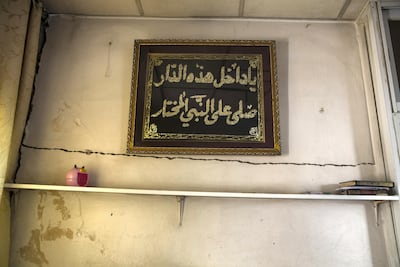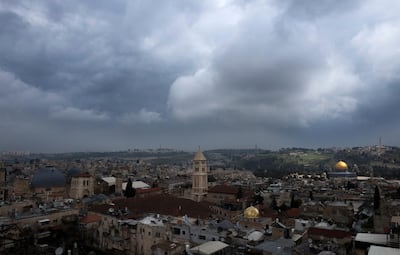Nisreen Awada can feel the status quo in Jerusalem literally shifting underneath her feet.
The Palestinian mother, 35, of six stays in a crumbling concrete home in Silwan, a contested East Jerusalem neighbourhood just beyond the Old City's walls.
Ms Awada's home, which she moved in to when she married at 17, has long been in need of renovations she could not afford. But now the ceiling is falling and there are cracks in the exterior walls.
Below Ms Awada's home, Israeli archaeologists, backed by a right-wing nationalist organisation, are digging a tunnel that they say traces a road Jewish worshippers used 2,000 years ago. This is now set to be part of a larger tourist and religious attraction.
Local activist Jawad Siyam says that the digging damaged more than 70 Palestinian homes in Silwan’s Wadi Hilweh district, displacing some residents.
The government denies the tunnels are causing the damage and there is no official study linking the two.
It’s just one of the many physical reminders for Palestinians of how East Jerusalem’s access and infrastructure is fundamentally shifting – and with it the fragile status quo and sovereignty that was once built upon it.
Although many of these changes were already happening before Donald Trump became US president in 2016, analysts tell The National that American support for Israel's extreme-right government has effectively given these projects a green light, despite the long-term consequences.
“It’s just trying to make East Jerusalem dead and immobile,” says Yara Hawari, a policy fellow with Al Shabaka, the Palestinian research network. “It’s about exerting [Israeli] power over the city and their dominance.”
Jordan ruled the east side of Jerusalem from 1948 to 1967. Israel captured the city in the 1967 War and soon after annexed it, a move most of the international community still does not recognise.
Peace plans have long proposed that East Jerusalem would be the capital of a Palestinian state, though it is unclear if the Trump administration’s long-awaited plan will continue with this precedent.
A third of Jerusalem’s population is Palestinian, but most are not Israeli citizens. Instead, they are permanent residents and must remain living in the city or risk losing their official status. Israel also bans the semi-autonomous Palestinian Authority based in the West Bank from operating in Jerusalem.

Today, about 70 per cent of East Jerusalem’s 350,000 residents live below the poverty line and unemployment is high. Even the number of playgrounds in Palestinian parts of Jerusalem is just one per cent of the national average, according to a 2015 lawsuit.
Each East Jerusalem neighbourhood has its own infrastructure and access issues. Life in the Old City, where paramilitary Israeli police patrol as tourists walk past, has a different feel from the Shuafat refugee camp on the West Bank side of the separation barrier or Isawiya, a tough neighbourhood where the Jerusalem light rail ends.
With almost no representation in the Jerusalem Municipality – most East Jerusalemites boycott Israeli local elections, the only elections they can vote in – each street, family or apartment block is left to fight their own battles.
But all residents can see the new Israeli roads, checkpoints and national parks infringe on their communities.
Tensions over access in the Old City – especially the Haram Al Sharif – are issues that can unite the city’s Palestinians.
In the summer of 2017, Palestinians protested when Israel installed metal detectors at the entrance to the Haram Al Sharif following a deadly attack there. The protests, while ostensibly about the gates, were really about sovereignty and resisting Israeli control of national and religious sites. It also epitomised one important realm through which the future of Jerusalem is contested – access and infrastructure.
In recent weeks, new protests and protest prayers broke out after Palestinians tried to enter the Bab Al Rahmeh to a prayer hall that Israel closed to Muslims in 2003 during the Second Intifada.
In another part of the Old City, tensions ran high when Israeli soldiers evicted a Palestinian family from their property, which Israeli settlers wanted to occupy.

Just a few minutes’ walk from these events, the main East Jerusalem entrance into the Old City is Damascus Gate, a centre of Palestinian life. This area – which teems with shoppers, worshippers and workers – has been a gathering place for political protests.
It has also been the site of many stabbing attacks by Palestinians against Israeli soldiers, especially during a wave of incidents in 2015.
So it did not surprise residents when Israel quickly completed new watchtowers at the gate’s entrance, providing a more entrenched position for Israeli forces to monitor the Palestinian population. “It’s sending a very clear message that it’s no longer your space and that we’ll constantly be watching you,” Ms Hawari said.
Back beyond the Old City’s walls in Silwan, Elad, an acronym for the City of David Foundation, is a right-wing organisation whose stated goal is in part to settle Jews in Palestinian parts of East Jerusalem.
The group is centred in Silwan which it believes to be where King David settled. Palestinians and human rights groups have accused Elad of using archaeology and Absentee Property Laws as a front for seizing Palestinian land, a claim that Elad denies.
“We can see that the settlers are working much faster and much more comfortably,” Mr Siyam said. “The only service we get [from the municipality] is demolishing houses.”
Already just up the street from Mr Siyam's community center is Elad's main tourist attraction, the City of David National Park. Last summer, a delegation of senior US officials, including US Ambassador to Israel David Friedman and National Security Advisor John Bolton, dined with Israeli counterparts there. Now the Israeli government is pushing forward with a controversial plan to build cable cars that would carry people across the Old City up Silwan – and to a new tourism centre being built by Elad.
“There are all sorts of settlement schemes pending,” said Daniel Seidman, an Israeli expert on Jerusalem.
Up the street from Mr Siyam’s community centre is Elad’s main tourist attraction, the City of David National Park. Last summer, a delegation of senior US officials, including American ambassador David Friedman and National Security Adviser John Bolton, dined with Israeli counterparts there.
Now the Israeli government is pushing forward a plan to build cable cars that will carry people across the Old City to Silwan – and to a new tourism centre being built by Elad.
“There are all sorts of settlement schemes pending,” said Daniel Seidman, an Israeli expert on Jerusalem.
Like Silwan, Sheikh Jarrah is another Palestinian neighbourhood where Jewish settler groups have focused their activities. Two hundred families in Sheikh Jarrah, the Old City, and Wadi Hilweh face eviction threats from settler organisations, according to Ir Amim, an Israeli NGO.
The roads in Sheikh Jarrah and in neighbouring Wadi El Joz, residents cynically note, only start to improve once Jewish residents move in. Settler groups used Israel’s Absentee Property Laws to seize Palestinian homes, or bought the buildings from Palestinian middlemen.
Many UN and international aid workers live in this area, further driving up prices.
Ala Al Qassem, 58, was born here and raised four children in her family’s home in Sheikh Jarrah. She now has cancer, and her husband lives in the West Bank city of Ramallah. Since 2001 he has been denied family reunification by Israel. Nonetheless, she will not leave her home – even as the pressures around her grow.
“Now we are facing the elections in Israel and we pay the price,” Ms Al Qassem said. “Because they want to have more voices for the settlers in the government.”
On the edges of Jerusalem, for more than a decade residents heard rumours of Israel cutting off the East Jerusalem communities now on the West Bank side of the separation barrier, such as Kafr Aqab, Shuafat and Ram.
Supporters of the move say this would end these communities’ “no-man’s land” status.
But opponents say it is a way to reduce Jerusalem’s Palestinian population. All of these pressures keep Mr Siyam busy. He’s constantly on the phone with lawyers, families and activists in Silwan worried about arrests and parking, building and other fines.
“Israel wants us to be busy with how you pay your lawyers, how you pay your tickets,” he says.
“They make your life full from the morning to the evening, full with the lawyers, the courts, the authorities.”
For now, “Israel is strong and the Palestinians are quiet,” Mr Siyam says. “You cannot count on this in five years that the Palestinians will be quiet.”


